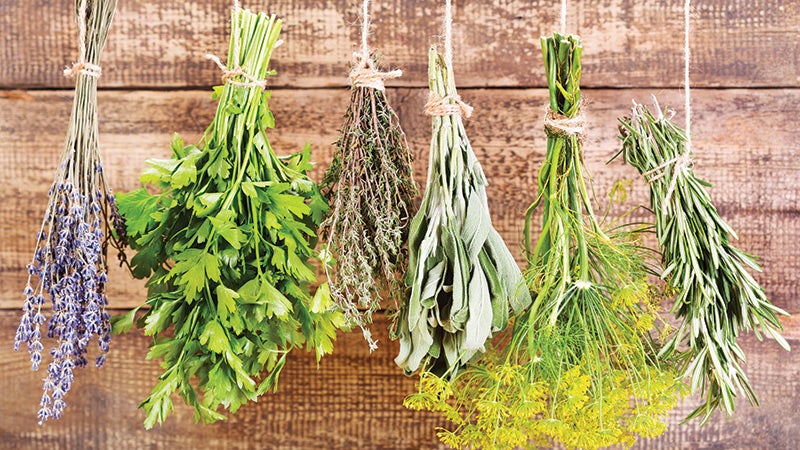Save Your Summer Herbs Now!

Snipping fresh herbs from the garden to use in summertime meals and drinks is one of gardening’s primary rewards. Another flavorful—and economical—benefit is how easily they dry for use in fall and winter cooking. Herbs that are homegrown and dried have an intenser, more robust flavor than store-bought herbs because their essential oils are fresh. Those expensive jars of herbs at your local supermarket may sit around for months while their flavors degrade. Once you’ve tasted homegrown oregano in tomato sauce, or spearmint in tea, you’ll never settle for supermarket herbs again. Air-drying is the easiest way to preserve most culinary herbs. Herbs that dry well include: chervil, dill, lemon balm, mint, oregano, parsley, rosemary, sage, savory, stevia, sweet marjoram, tarragon, and thyme.
“For the best flavor, plan on harvesting your herbs before they flower,” says Rose Marie Nichols McGee, president of Nichols Garden Nursery in Albany, Oregon, and co-author (with Maggie Stuckey) of The Bountiful Container (Workman, 2002). “In the morning after the dew has dried is the best time to pick herbs, before the heat of the day volatilizes the oils.”
Nichols McGee’s 5-step primer for harvesting and drying herbs
1. Harvest
Gather a small handful of stems, no more than a half-inch in diameter.
2. Wrap
Secure each bundle by wrapping a rubber band tightly around the stems. The band will contract as the stems dry, so none will slip through, as can happen with string.
3. Hang
Hang the herbs to dry out of direct sunlight, in a warm, dark place with good ventilation and low humidity, to keep mold from growing.
4. Spread
Some herbs, such as bay leaves and chives, dry best when spread on a screen.
5. Wait
Herbs are dry when they feel crisp and crumble readily; this can take a couple of weeks to a month-plus, depending on the water content of the leaf.
Tip
Don’t bother drying basil and cilantro, McGee says, because their flavor loses its oomph. Her method is to process a handful of fresh leaves and a little water together in a blender to create a thick near-paste. She freezes the mixture in ice-cube trays. “Drop a couple cubes into tomato or vegetable soup, and it’s summer all over again,”
she says.
Want more gardening info right at your fingertips? Check out the new Vegetarian Times Magazine Library with more than 3,700 recipes plus lots of garden, cooking and nutrition tips!
DO Dry only healthy stems. Remove any with diseased leaves or insect damage. Rinse with cool water if they are dusty, and shake or blot with paper towels to remove most of the water. If herbs are clean, don’t get them wet.
DO Cut the stems of vigorous, leafy herbs like dill, mint, oregano, parsley, and tarragon any time up until the first frost.
DO Collect seeds of caraway, coriander, cumin, and dill for recipes. Harvest the stems when seedpods have browned. To catch seeds, cover pods with paper bags and secure with ties. Dry as described in sidebar at left.
Don’t Harvest woody perennial herbs like rosemary and sage less than one month before your predicted first frost date. Pruning encourages new growth, which frost may kill. Cut no more than a third of the stems at
a time.
Don’t Use dehydrators, microwaves, or the oven. These methods can over-dry the herbs, sacrificing flavor.
Don’t Keep them too long. Use dried herbs within a year (mints hold their flavor up to two years). Store in a dry place away from sunlight, and discard at any sign of mold.